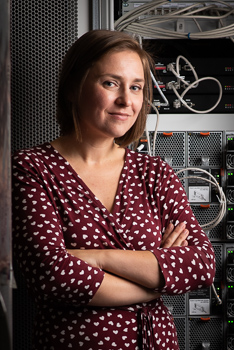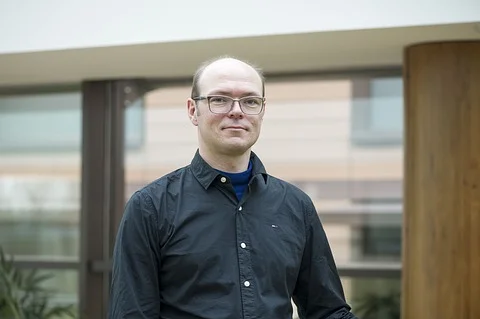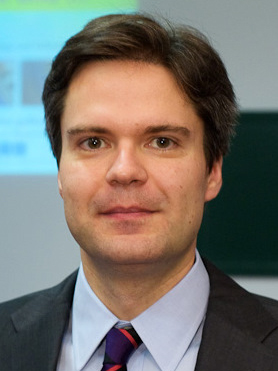(In the) News
Curriculum Vitae
Research
START Project
Publications: Journals
Publications: Conferences
Invited Presentations
Teaching
MLTUW
Clemens Heitzinger's
homepage!
1 MLTUW — Machine Learning at TU Wien
MLTUW is a newly founded initiative and platform that promotes the use and development of advanced and reliable machine-learning (ML) methods in science and technology at TU Wien (TUW).
It started from several discussions and subsequent collaborations between the founding members, having been trying to close the gap between the theory of modern machine-learning methods and the desire to extract knowledge and information in a reliable manner from the data sets that we have been gathering. While artificial neural networks have seen a great revival in recent years especially in imaging, we are open to any well-founded ML method.
We quickly realized the need for more regular meetings and in-depths discussions, also with our students, in order to advance the state of the art and to grasp the opportunities that stem from bringing together experts in the theory of ML and experts in their application domains.
Our team is balanced between researchers that are active in theory and applications. Currently the scope of our initiative includes the following.
- Theory:
- (computational) Bayesian estimation/inversion,
- decision theory,
- deep learning,
- reinforcement learning.
- Applications:
- computational materials science,
- imaging of surfaces,
- radar data and climate,
- single-molecule imaging.
Our initiative is research oriented and fits perfectly into the strategic goals of TUW and in particular into its “digitalization” strategy and its “research matrix” (computational science and engineering, computational materials science, mathematical and algorithmic foundations, computer science foundations, modeling and simulation, nanoelectronics, surfaces and interfaces, materials characterization, biological and bioactive materials, automation and robotics, digital transformation in manufacturing, sensor systems, etc.).
MLTUW benefits from its close ties to Molecular and Elemental Imaging in Biosciences (MEIBio), another grass-roots initiative that is by now a well-established collaboration between imaging experts at TUW. Some of our members are also involved in the Vienna Center for Engineering and Medicine (VICEM), a collaboration between TUW and the Medical University of Vienna. Furthermore, some of us are members of the BioInterface network at TUW.
For students, our initiative provides a path and platform from curricula at TUW such as
- the Master program Technical Mathematics,
- the Master program Technical Physics,
- the Master program Technical Chemistry,
- the Master program Informatics,
- the Master program Data Science,
- the Master program Medical Informatics,
- the Master program Biomedical Engineering,
- etc.
to their PhD studies at a high international level.
2 Members
Currently our team includes researchers from four departments at TUW. In alphabetical order:
2.1 Emanuela Bianchi (Physics)

Homepage
I work in the soft condensed matter field with focus on colloidal and polymer-based systems. I use theoretical (mean field) and numerical (Monte Carlo and molecular dynamics) approaches to investigate the collective behaviors of (appropriately developed models of) soft-matter systems. My broad-range goal is to design units with heterogeneously patterned surfaces in order to steer the self-assembly of materials with well-defined architectures and tunable properties.
2.2 Ivona Brandic (Computer Science)

Homepage
Page about START project
In my research I apply data science methods to analyze and optimize large-scale distributed systems. We utilize Dynamic Bayesian Networks in order to discover dependencies in distributed systems and thus to develop failure tolerant systems. To achieve energy efficient systems, we perform computation offloading and first-hop data-reduction techniques. Further, we address the critical challenge of staleness control in the distributed data-stream processing focusing on the consistency management of the machine-learning models in distributed worker nodes.
2.3 Martina Marchetti-Deschmann (Chemistry)

Homepage
Decreasing limits of detection and quantification and increasing sample complexity demand sophisticated sample preparations and modern, high-end instrumentation. Our vision is to develop new methodologies and strategies to ultimately obtain qualitative and quantitative analyte information using mass spectrometry as the key technology. We detect analytes at lowest concentrations not only in bulk material, but also provide information on analyte distributions in samples. Liquid chromatography and electrophoresis, both also in hyphenation to soft ionization techniques such as ESI, DESI, and MALDI, all in combination with high- and low-resolution mass spectrometers such as ToF, FT-ICR, ion mobility separation, iontraps, and triple quadrupole instrumentation constitute the core of our research. We answer research questions in many fields from life sciences to material sciences, in omics technologies, structural biology, but also in imaging mass spectrometry, just to name a few.
2.4 Klaus Felsenstein (Mathematics)
Klaus Felsenstein is an expert in Bayesian statistics and decision theory.
2.5 Peter Filzmoser (Mathematics)

Homepage
Peter Filzmosers’s research interests include robust statistics, multivariate analysis, compositional data analysis, geostatistics, and many more.
2.6 Thomas Gärtner (Computer Science)

Homepage
My main research interests are efficient and effective machine learning and data mining algorithms. Machine learning considers the problem of extracting useful functional or probabilistic dependencies from a sample of data. Such dependencies can then, for instance, be used to predict properties of partially observed data. Data mining is often used in a broader sense and includes several different computational problems, for instance, finding regularites or patterns in data. By efficiency I mean on the one hand the classical computational complexity of decision, enumeration, etc. problems but on the other hand also a satisfactory response time that allows for effectiveness. By effectiveness I mean how well an algorithm helps to solve a real world problem. My recent focus is on challenges relevant to the constructive machine learning setting where the task is to find domain instances with desired properties and the mapping between instances and their properties is only partially accessible. This includes structured output prediction, active learning/search, online learning/optimization, knowledge-based learning and related areas. I am most interested in cases of this setting where at least one of the involved spaces is not a Euclidean space but for instance the set of graphs. My approach in many cases is based on kernel methods where I have focussed originally on kernels for structured data, moved to semi-supervised/transductive learning, and am currently looking at parallel/distributed approaches as well as fast approximations. The most recent knowledge-based kernel method was for instance focusing on interactive visualizations for data exploration. Application areas which I am often considering when looking for novel machine learning challenges are chemoinformatics and computer games.
2.7 Radu Grosu (Computer Science)

Homepage
Radu Grosu’s scientific interests include model-based design, analysis and control of complex dynamic systems; model checking, abstract interpretation, logic and automata theory, control theory; computational models in systems biology; applied formal methods, software and systems engineering, UML.
2.8 Clemens Heitzinger (Mathematics; Coordinator)

Homepage
Clemens Heitzinger is an expert in stochastic partial differential equations, (computational) Bayesian PDE inversion, and reinforcement learning. Applications he has worked on include nanotechnological sensors, electrical-impedance tomography, and optimal policies in discrete-event simulation.
2.9 Thomas Melzer (Mathematics/Geoinformation)
2.10 Florian Mittendorfer (Physics)

Homepage
Florian Mittendorfer’s research is focused on obtaining a fundamental understanding of the electronic and catalytic properties of materials on the basis of density-functional-theory calculations and many-electron approaches. Recent research fields include the functionalization of materials used in energy conversion, the physics of quasi two-dimensional systems and the growth of nanostructures.
2.11 Peter Mohn (Physics)

Homepage
Peter Mohn’s research interests include computational materials science, solid state magnetism, magnetism at finite temperatures, electronic structure of solids, and magnetic semiconductors.
2.12 Gerhard Schütz (Physics)

Homepage
Biophysics is a highly interdisciplinary field which attempts to bridge the gap between biology and physics. Biology studies life in its variety and complexity. On the other hand, physics looks for mathematical laws of nature and makes detailed predictions about the forces that drive physical systems. The combination of these two seemingly opposing objectives is the challenge biophysics faces.
In our group, we use single-molecule-microscopy techniques to gain insights into general aspects of membrane biophysics, neuroscience and immunology. By monitoring the localization and the dynamics of biomolecules we aim to understand their function in model systems as well as in living cells. The main tools used in our lab are fluorescence microscopy, Förster resonance energy transfer (FRET) as well as super-resolution imaging (STORM, PALM) and atomic-force microscopy (AFM).
2.13 Wolfgang Wagner (Mathematics/Geoinformation)

Homepage
Wolfgang Wagner was born in Wels, Austria, in 1969. He received the Dipl.-Ing. (MSc) degree in physics and the Dr.techn. (PhD) degree in remote sensing, both with excellence, from the Vienna University of Technology (TU Wien), Austria, in 1995 and 1999 respectively. In support of his master and PhD studies he received fellowships to carry out research at the University of Bern (1993), Atmospheric Environment Service Canada (1994), NASA Goddard Space Flight Centre (1995), European Space Agency (1996), and the Joint Research Centre of the European Commission (1996-1998). From 1999 to 2001 he was with the German Aerospace Agency (DLR), first as a project assistant at the Institute of High Frequency Technology and later as the head of the SAR Applications team at the German Remote Sensing Data Centre. In 2001 he was appointed professor for remote sensing at the Institute of Photogrammetry and Remote Sensing of TU Wien. From 2006 to 2011 he was the head of the Institute of Photogrammetry and Remote Sensing, and since October 2012 he has been the head of the newly founded Department of Geodesy and Geoinformation. Furthermore, he is co-founder of the Earth Observation Data Centre for Water Resources Monitoring (EODC), where he has worked part-time as senior scientist since December 2014. Since 2018 he has also been affiliated with the Global Change Research Institute of the Czech Academy of Sciences (CzechGlobe), giving advise on the use of EO data within the framework of an European project aiming to develop adaptation strategies for sustainable ecosystem services and food security.
3 How to Join Us
We are an open initiative. If you are interested in attending our regular meetings and/or if you are interested in joining us, just send us a message.